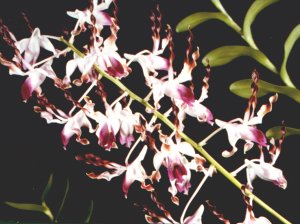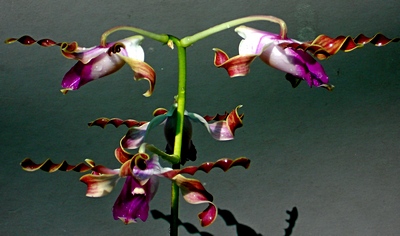|
|
|
CONTACT US
Click Here! |
| This site is best viewed with a screen resolution of 800 X 600 at high colour settings |
|
Flask List
Acacallis-Ancistrochilus Angraecum-Aspasia Barkeria-Broughtonia Bulbophyllum Capanemia-Catasetum Cattleya Cattleyopsis-Cycnoch, Cymbidium-Cyrtorchis Dendrobium-Dossinia Encyclia-Eulophiella Galeandra-Jumellea Laelia-Lycaste Macodes-Nephalaphyll, Odontogloss,-Oncidium Paphiopedilum-Psychilis Rangaeris-Stenocoryne Tainia-Zygopetalum Nervilia Plant & Flask list Spathoglottis |
|
Plant List
Acampe-Bulbophyllum Cattleya-Dossinia Encyclia-Promeaea Renanthera-Vanda Nervilia Plant & Flask list Spathoglottis |

Captain Blood's Sepik Blue Dendrobium ostrinoglossum.
"Would you have a plant of the Sepik Blue orchid?", a request from Susan Connor. A typical enquiry, until she said she would like one because her father had discovered it in New Guinea, and her maiden name was Blood.


Yes, we grow this species from seed. It is a warm growing Ceretobe Dendrobium from a wet and hot part of the world, the Sepik River of North West New Guinea.
A rampant grower, it requires a well drained shallow pot or basket, with a rich media that will also drain well but retain moisture, to stay just damp but not wet. Maximum sunlight, even to slight leaf burn, will ensure flowering, and ofcourse a warm place if you do not live in the wet tropics.
When the plant is in active growth, a lot of fertiliser will be of benefit. While the plant can grow to metres high, a small pot with a bit of excess sunlight tends to keep the canes managable. On replying to Susan, I asked if she knew the details of her fathers discovery.
Susan's reply; My fathers full name was Neptune Newcombe Beresford Lloyd Blood, and he is credited with the discovery of the Sepik Blue Dendrobium ostrinoglossum ( Dend lasianthera), described and named by Reverend H.M.R.Rupp. All I know is that he most probably found it, when saving WW11 pilots that were downed in the Sepik Area, as he was a Captain in the Australin Army, but since he had intimate knowledge of New Guinea, he usually found them and lead them to safety .....or carried them, one was a trek of some 60 odd days....with no food and only he and his "police boy".
Dad discovered a Bird of Paradise,which was named after him, a very 'ugly' bird as I said to Dad, why couldn't you find something outstandingly beautiful??......"because they are garish and everyone sees them, I look behind the scenes and find the hidden beauty, and the ones everybody tends to overlook or forget". He sent many hundreds of specimen to the Sydney Museum, which one notable author/naturalist has made good work for himself with Dad's work.....and of course with all the inhabitants from New Guinea at Taronga Park Zoo in Sydney.....also in Sweden ....and Singapore......
My Father was a very private man, and did not think that anything he did was of any importance to the grand scheme of things.....and so I didn't get a chance to find out and document any and all of his exploits, both pre war and post war.......and all the 40 odd years he spent in New Guinea.
He came to New Guinea and served as a Superintendant of Police, then when war broke out, he joined the Australia Army. When the war was over, he became a Patrol Officer for a short while, but when Sir Edward Hallstrom offered him a job to start the first Experimental Sheep Farm in the Highlands, he took it so he could concentrate on that and his need to be a Naturalist.
After that, instead of going back to being a Patrol Officer, he decided to become a Agricultural Officer, more in keeping with his love of the plant Kingdom..... You would have loved to see his Orchid House.....and his freshwater aquariums, and saltwater aquariums, and his birds and his animals and butterflies, and when we were in the Highlands of New Guinea, he had 20 acres of English Country Gardens.....which were truly a sight to see.
So here is another species orchid with special significance for a grower, and its history surely of interest to any species grower. May the seedlings blossom and always remind you of Captain Blood. ( The bird of paradise is Epimachus bloodi, a subspecies of E. meyeri, Central Highlands Brown Sicklebill, a large dark brown bird with a long curved bill.)
Ian Walters.
For more photos PHOTOS